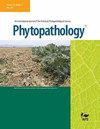求助PDF
{"title":"过表达α-SNAPRhg1可提高rhg1-a介导的大豆对大豆囊肿线虫的抗性。","authors":"Deepak Haarith, Soumita Das, Emma Nelson, Ryan Zapotocny, Andrew F Bent","doi":"10.1094/PHYTO-02-25-0077-R","DOIUrl":null,"url":null,"abstract":"<p><p>The <i>rhg1-a</i> and <i>rhg1-b</i> haplotypes of the soybean <i>Rhg1</i> locus are economically effective tools for the control of soybean cyst nematode (SCN; <i>Heterodera glycines</i>), but ongoing SCN evolution requires improved sources of resistance. Both <i>Rhg1</i> haplotypes carry multiple tandem repeat copies of a four-gene block encoding four disparate proteins, and resistance efficacy scales with copy number. The haplotypes encode different variants of an unusual α-SNAP protein whose abundance increases in the nematode-reprogrammed plant cells that form the syncytium (nematode feeding site), which subsequently collapses. The present study explored the simultaneous presence of two α-SNAP<sub>Rhg1</sub> protein types and elevation of α-SNAP<sub>Rhg1</sub> abundance, which were hypothesized to improve SCN resistance but are not achievable by conventional soybean breeding. We accomplished both via transgenic additions to an <i>rhg1-a Rhg4</i> soybean line. Existing resistance to the HG type 0 and HG type 2.5.7 SCN was strengthened, measured as cyst production and final SCN egg counts, but resistance was not improved against an HG type 1.3.6.7 SCN population that was already highly virulent on the parent line. Greenhouse and field studies with a subset of lines showed no significant yield penalties. We conclude that cisgenic combination or elevated expression of the different α-SNAP genes may extend the efficacy and/or durability of <i>Rhg1</i>-mediated resistance. We also observed differential protein abundances for some α-SNAP<sub>Rhg1</sub> isoforms after inoculation with different HG type populations of SCN. The studies provide a foundation for further refinement of <i>Rhg1</i>-based SCN control. [Formula: see text] Copyright © 2025 The Author(s). This is an open access article distributed under the CC BY-NC-ND 4.0 International license.</p>","PeriodicalId":20410,"journal":{"name":"Phytopathology","volume":" ","pages":"1165-1174"},"PeriodicalIF":3.1000,"publicationDate":"2025-09-01","publicationTypes":"Journal Article","fieldsOfStudy":null,"isOpenAccess":false,"openAccessPdf":"","citationCount":"0","resultStr":"{\"title\":\"Overexpression of α-SNAP<sub>Rhg1</sub> Can Improve <i>rhg1-a</i>-Mediated Soybean Resistance to Soybean Cyst Nematode.\",\"authors\":\"Deepak Haarith, Soumita Das, Emma Nelson, Ryan Zapotocny, Andrew F Bent\",\"doi\":\"10.1094/PHYTO-02-25-0077-R\",\"DOIUrl\":null,\"url\":null,\"abstract\":\"<p><p>The <i>rhg1-a</i> and <i>rhg1-b</i> haplotypes of the soybean <i>Rhg1</i> locus are economically effective tools for the control of soybean cyst nematode (SCN; <i>Heterodera glycines</i>), but ongoing SCN evolution requires improved sources of resistance. Both <i>Rhg1</i> haplotypes carry multiple tandem repeat copies of a four-gene block encoding four disparate proteins, and resistance efficacy scales with copy number. The haplotypes encode different variants of an unusual α-SNAP protein whose abundance increases in the nematode-reprogrammed plant cells that form the syncytium (nematode feeding site), which subsequently collapses. The present study explored the simultaneous presence of two α-SNAP<sub>Rhg1</sub> protein types and elevation of α-SNAP<sub>Rhg1</sub> abundance, which were hypothesized to improve SCN resistance but are not achievable by conventional soybean breeding. We accomplished both via transgenic additions to an <i>rhg1-a Rhg4</i> soybean line. Existing resistance to the HG type 0 and HG type 2.5.7 SCN was strengthened, measured as cyst production and final SCN egg counts, but resistance was not improved against an HG type 1.3.6.7 SCN population that was already highly virulent on the parent line. Greenhouse and field studies with a subset of lines showed no significant yield penalties. We conclude that cisgenic combination or elevated expression of the different α-SNAP genes may extend the efficacy and/or durability of <i>Rhg1</i>-mediated resistance. We also observed differential protein abundances for some α-SNAP<sub>Rhg1</sub> isoforms after inoculation with different HG type populations of SCN. The studies provide a foundation for further refinement of <i>Rhg1</i>-based SCN control. [Formula: see text] Copyright © 2025 The Author(s). This is an open access article distributed under the CC BY-NC-ND 4.0 International license.</p>\",\"PeriodicalId\":20410,\"journal\":{\"name\":\"Phytopathology\",\"volume\":\" \",\"pages\":\"1165-1174\"},\"PeriodicalIF\":3.1000,\"publicationDate\":\"2025-09-01\",\"publicationTypes\":\"Journal Article\",\"fieldsOfStudy\":null,\"isOpenAccess\":false,\"openAccessPdf\":\"\",\"citationCount\":\"0\",\"resultStr\":null,\"platform\":\"Semanticscholar\",\"paperid\":null,\"PeriodicalName\":\"Phytopathology\",\"FirstCategoryId\":\"97\",\"ListUrlMain\":\"https://doi.org/10.1094/PHYTO-02-25-0077-R\",\"RegionNum\":2,\"RegionCategory\":\"农林科学\",\"ArticlePicture\":[],\"TitleCN\":null,\"AbstractTextCN\":null,\"PMCID\":null,\"EPubDate\":\"2025/9/9 0:00:00\",\"PubModel\":\"Epub\",\"JCR\":\"Q2\",\"JCRName\":\"PLANT SCIENCES\",\"Score\":null,\"Total\":0}","platform":"Semanticscholar","paperid":null,"PeriodicalName":"Phytopathology","FirstCategoryId":"97","ListUrlMain":"https://doi.org/10.1094/PHYTO-02-25-0077-R","RegionNum":2,"RegionCategory":"农林科学","ArticlePicture":[],"TitleCN":null,"AbstractTextCN":null,"PMCID":null,"EPubDate":"2025/9/9 0:00:00","PubModel":"Epub","JCR":"Q2","JCRName":"PLANT SCIENCES","Score":null,"Total":0}
引用次数: 0
引用
批量引用

 求助内容:
求助内容: 应助结果提醒方式:
应助结果提醒方式:


